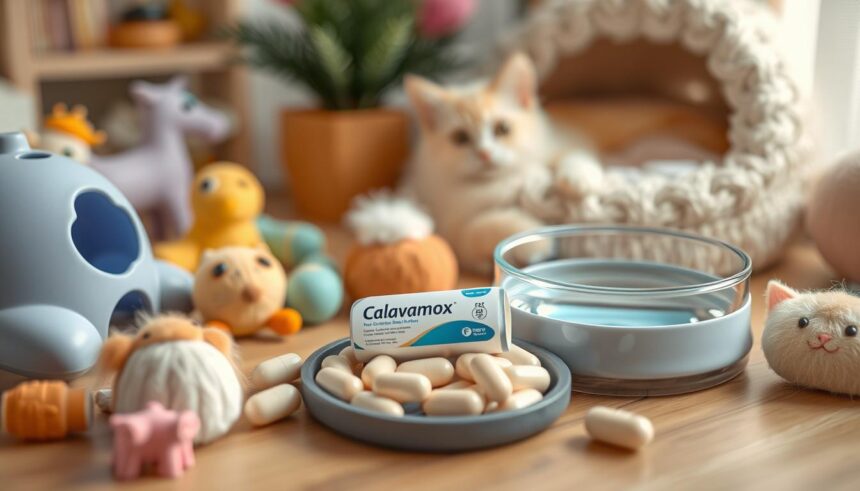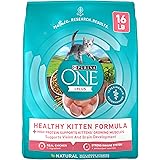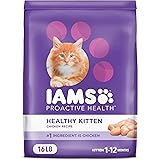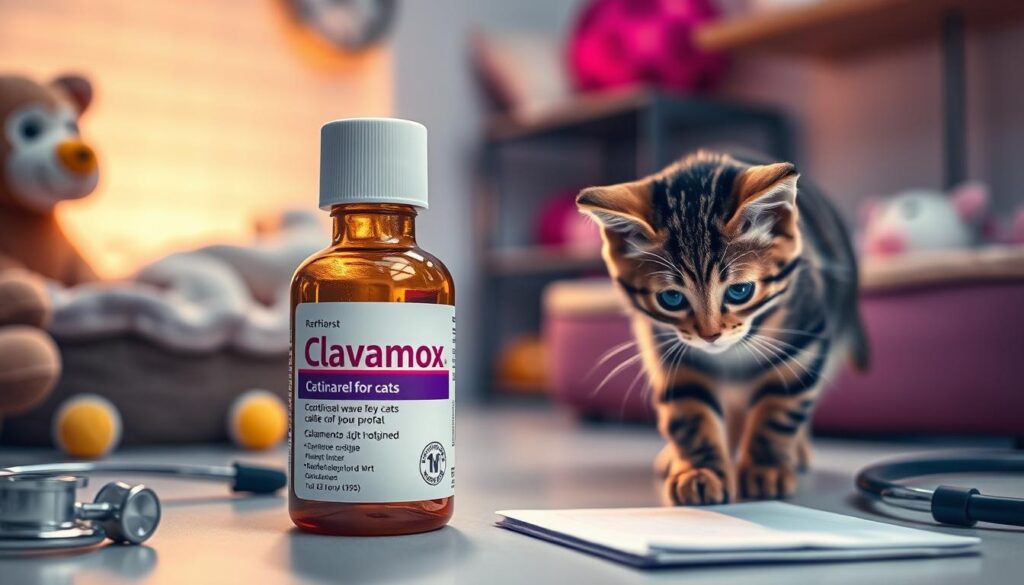Did you know Clavamox is a top pick for cat antibiotics? Many vets use it to fight off bacterial infections. It’s a mix of amoxicillin and clavulanic acid, offering strong protection against many bacteria. Cats usually get 62.5 mg every 12 hours, making it a simple and effective choice.
Key Takeaways
- Clavamox is a broad-spectrum antibiotic used to treat bacterial infections in cats.
- The recommended Clavamox dosage for cats is 62.5 mg per cat every 12 hours.
- Clavamox for cats is effective against a range of bacteria, including Gram-negative and Gram-positive bacteria.
- Clavamox should be given with food to minimize potential stomach upset and side effects.
- The treatment course with Clavamox typically ranges from 5 days to 2 weeks, but should not exceed 30 consecutive days.
- Clavamox is not recommended for pregnant or lactating cats due to insufficient safety testing.
- It’s crucial to follow the prescribed Clavamox dosage for cats and administration schedule to ensure effective treatment and prevent antibiotic resistance.
Understanding Clavamox for Cats
Clavamox is a prescription drug for cats with bacterial infections. It combines amoxicillin and clavulanic acid to fight infections. These can include urinary, respiratory, and skin infections. It comes in tablets and liquid, given orally.
Pet owners often wonder how long Clavamox takes to work. It starts working a few hours after use. But, it may take up to five days to see clear results. Always follow the dosage and schedule given by your vet. Using Clavamox without a vet’s prescription can be risky.
Bedsure Cute Cat Couch for Pets – Fluffy Cat beds with Premium Soft Corduroy Fleece, Fuzzy Cats beds for Indoor Cats with Removable Washable Cover, Supportive Pet Sofa, 24inch, Cream
Blink Outdoor 4 – Wireless smart security camera, two-year battery life, 1080p HD day and infrared night live view, two-way talk. Sync Module Core included – 3 camera system
Bedsure Calming Dog Bed Medium Size Dog – Donut Washable Medium Pet Bed, 30 inches Anti-Slip Round Fluffy Plush Faux Fur Cat Bed, Fits up to 45 lbs Pets, Camel
Purina Fancy Feast Tender Ocean Whitefish, Turkey, Chicken and Salmon Feasts Wet Kitten Food Variety Pack – (Pack of 24) 3 oz. Boxes
Purina ONE High Protein, Natural Dry Kitten Food, +Plus Healthy Kitten Formula – 7 lb. Bag
Purina Friskies Wet Cat Food Pate Variety Pack Salmon Dinner, Turkey and Giblets Dinner and Mixed Grill – (2 Packs of 12) 5.5 oz. Cans
Dr. Elsey’s Ultra UnScented Clumping Clay Cat Litter 40 lb. Bag
TP-Link Tapo 2K Pan/Tilt Security Camera for Baby Monitor, Dog Camera w/Motion Detection, 2-Way Audio, Siren, Night Vision, Cloud & SD Card Storage, Works with Alexa & Google Home, 2-Pack (C210P2)
Purina ONE High Protein, Natural Dry Kitten Food, +Plus Healthy Kitten Formula – 16 lb. Bag
IAMS Proactive Health Healthy Kitten Dry Cat Food with Chicken, 16 lb. Bag
What is Clavamox?
Clavamox is a mix of amoxicillin and clavulanate potassium. It’s for treating bacterial infections in cats and dogs. You can only get it with a vet’s prescription.
How Clavamox Works
Clavamox stops bacteria from making cell walls, killing them. The mix of amoxicillin and clavulanic acid makes it effective against more bacteria.
Common Uses in Feline Medicine
Clavamox treats skin, urinary, and respiratory infections in cats. It can cause side effects like upset stomach, vomiting, and diarrhea. Watch your cat for these clavamox side effects in cats while they’re on the medication.
Stick to the dosage and schedule to avoid side effects and get the best results. If you’re worried or have questions, talk to your vet.
| Medication | Form | Dosage |
|---|---|---|
| Clavamox | Tablet or liquid | 13.75 mg/kg for dogs, 62.5 mg/cat twice daily |
The Strength and Effectiveness of Clavamox
Clavamox is a common antibiotic for pets, found in tablets and liquid, like clavamox liquid for cats. It fights many bacterial infections, such as urinary, respiratory, and skin infections. Many clavamox for cats reviews say it’s safe and has few side effects.
The mix of amoxicillin and clavulanic acid in Clavamox works against many bacteria. But, it’s key to follow the dosage and watch for any bad reactions in your cat.
Clavamox is used for many things, like treating wounds, skin infections, urinary tract infections, and respiratory infections. But, it’s not safe for small animals like ferrets, rabbits, guinea pigs, chinchillas, or hamsters. Also, its safety during pregnancy or for breeding animals is unknown.
| Form | Dosage | Frequency |
|---|---|---|
| Oral suspension | 62.5 mg to 1000 mg | Twice daily |
| Tablets | 62.5 mg to 1000 mg | Twice daily |
Clavamox is a powerful antibiotic for cats. It comes in different forms, including clavamox liquid for cats, making it easy for pet owners to use. By following the dosage and watching your cat’s response, you can help make sure the treatment works well.
Proper Dosage Guidelines
When treating cats with Clavamox, it’s key to follow the right dosage. The amount needed depends on the infection type, its severity, the cat’s age, and weight. For instance, treating upper respiratory infections in cats might need a different dose than for diarrhea.
Hartz Delectables Stew Lickable Wet Cat Treats for Adult & Senior Cats, Variety Pack, 1.4 Ounce (Pack of 12)
Fresh Step Clumping Cat Litter, Multi-Cat, Long Lasting Odor Control Kitty Litter with Activated Charcoal, Low Dust Formula, 14 lb
LHBcraft Outdoor Cat House Weatherproof Insulated for Winter Outside, Feral Cat Houses for Outdoor Indoor Cats Shelter, Durable Resin Shelter for Garden, Patio, Easy to Assemble Black
5% OffINABA Churu Cat Treats, Grain-Free, Lickable, Squeezable Creamy Purée Cat Treat/Topper with Vitamin E & Taurine, 0.5 Ounces Each Tube, 50 Tubes, Tuna & Chicken Variety
Delectables Squeeze Up Variety Pack, Creamy Squeezable Puree, Lickable Wet Cat Treats, Grain Free, No Added Fillers, No By-Products, No Added Preservatives, 0.5 Ounces Tube, 24 Tubes Total
Purina Friskies Gravy Wet Cat Food Variety Pack, Surfin’ and Turfin’ Prime Filets Favorites – (Pack of 40) 5.5 oz. Cans
LUCKLIFE 52″ Christmas Cat Tree with 2 Cozy Houses,Indoor Modern Cat Tower with Anti-Tip Kit,Plush Perches & Hanging Balls,Holiday Cat Climbing Furniture for Kittens to Play and Sleep
Purina Friskies Wet Cat Food Variety Pack, Tasty Treasures Prime Filets (With Ocean Fish and Tuna, With Chicken and With Turkey) – 5.5 Ounce (Pack of 12)
HICC PET Cat Chin Acne Finger Wipes – Gentle Enzyme Complex Care for Feline Acne & Blackheads, Vet Recommended Daily Chin Cleaning Wipes, No-Rinse Natural Formula
Fancy Feast Poultry and Beef Feast Classic Pate Collection Grain Free Wet Cat Food Variety Pack – (Pack of 30) 3 oz. Cans
The usual dose for cats is 62.5 mg twice a day. It’s vital to stick to the dosage to avoid side effects. The treatment length and how often to give it will vary based on the infection. For skin and soft tissue infections, treatment lasts 5-7 days or until symptoms clear up, up to 30 days max.
Weight-based Dosing
The Clavamox dose is based on the cat’s weight. It’s important to calculate the right dose for it to work well. The recommended dose is 62.5 mg twice a day, and following the instructions is crucial to avoid problems.
Frequency of Administration
Clavamox is given orally, and how often depends on the infection. For example, cats with urinary tract infections might need treatment for 10-14 days, not more than 30 days.
Duration of Treatment
The treatment length with Clavamox varies by infection type and severity. It’s important to follow the dosage instructions and watch for any bad reactions. The longest treatment with Clavamox should not go over 30 days in cats.
| Infection Type | Duration of Treatment |
|---|---|
| Skin and soft tissue infections | 5-7 days or 48 hours after symptoms disappear |
| Urinary tract infections | 10-14 days or longer, not exceeding 30 days |
Timing and Administration Schedule
Administering Clavamox to cats with urinary tract infections (UTI) requires careful timing and scheduling. The veterinary form of amoxicillin + clavulanate comes in various sizes, from 62.5 to 400 mg tablets and a 50 mg/ml liquid. The dose of amoxicillin is 5 to 12 mg per pound (10 to 25 mg/kg) given two or three times a day. This is key for treating clavamox for cats uti effectively.

- 🐱 【Multifunctional Activity Center】The cat Tree provides 3 top perches platforms and two cozy condo. Whether your kitten wants to stretch out on a spacious perch, curl up in a plush hole room, or release the urge to scratch on a sisal pole, this multifunctional cat tree tower works perfectly as a recreation paradise,which can make your fur baby's day full of fun and excitement!two toys gives them a unique way and Fun to play!
- 🐱【 Large Space Vertical】Because of its compact footprint and ability to conserve floor space, the cat tree design offers a large amount of vertical space. Every cat can have their own zone thanks to the cat jumping platform, which is another way that modern cat trees promote indoor cat peace. Maximum Load Capacity: 44 lbs. If your cat is too big for this cat tree, please buy one for tiny and medium-sized cats!
- 🐱 【Stable Construction】Our Cat Tower is made of high-quality particle board with skin friendly plushy faux-fur cover to keep your cat warm and comfortable. The cat activity tree has a wall anchor strap which provides a good double security protection. You don't have to worry that the cat tree will overturn or shake accidentally.Give your cat the best protection!ideal for average kittens and cats.
- 🐱 【Posts for Scratching Covered in Sisal 】These are scratching surfaces that are integrated into the framework. Cats love to bury their claws in sisal because it's a sturdy substance with a coarse texture. Our cat tree promotes healthy scratching habits and helps discourage cats from damaging furniture by offering dedicated spaces for them to scratch.
- 🐱 【Simple assembly】We understand that convenience is important to pet owners, which is why we made our cat tree simple to assemble in a matter of minutes. You can quickly provide your kitties a stimulating environment by following the simple setup instructions and using the available tools. Please feel free to contact us with any questions you may have about our cat tree, and we will respond to you within a day!

- Teething Fun: Ideal for kittens and cats alike, these chew toys are an essential addition to your kitty’s dental care. With natural gall fruit and rope design, the toys are perfect for teething and teeth cleaning, they combat tartar and freshen breath, making dental hygiene a fun activity for your little one!
- Infused with Catnip Aroma: The included catnip bag emits a soothing aroma that's irresistible to felines, ensuring these toys are a calming and engaging presence for indoor play. Our cat toys provide the calming, meow-inducing fun every kitten craves, along with a funny and interactive experience.
- Energetic Exercise: Promote healthy exercise and self-play with our toys' appealing textures and tassels. They’re designed to entice your kitty to bite and play aggressively without harm, offering hours of exercise and self-amusement, keeping your cat active and happy.
- Quiet Play: These soft colorful ropes provide enriching quiet playtime without bothering cat owner's sleep or life. Your kitty will love the funny snake-like shapes, enhancing their playtime with every pounce and bite.
- Safe and Organic: These chew toys, handcrafted without any metal wire and using organic cotton rope, are safe for all cats. Paired with a reusable catnip bag, they’re an essential, eco-friendly addition to your cat’s enrichment collection.

- MADE WITH WHOLESOME INGREDIENTS YOU CAN TRUST: Every Inaba product is made with yummy ingredients including farm-raised chicken and/or wild-caught tuna
- KEEP OUR FELINE HYDRATED WITHOUT ADDING CALORIES: Each delicious, creamy Churu tube contains 91% moisture and only 6 calories (a tenth of the calories of traditional dry cat treats), which makes it a healthy snack you can feel good about feeding
- FREE OF THE BAD STUFF: Your feline friend is important to us, which is why we've kept things like grains, preservatives, artificial colors and carrageenan out of our cat treats, but we added things like Vitamin E for immunity
- HAVE THEM EATING OUT OF YOUR HAND: These lickable purée meat tubes for cats were designed to be fed by hand, as an interactive way to spend time with your feline, but you can use as a wet/dry cat food topper or as a way to disguise medication
- ADD SOME VARIETY TO YOUR CAT'S LIFE: Available in eleven savory flavors, cats of all stages (kitten to senior) will be able to find a flavor they love

- FREEZE-DRIED RAW MINNOWS CAT TREAT: Vital Essentials Freeze Dried Cat Treats pack more protein than industry standard into every bite to deliver the peak vitality your dog deserves. Our natural freeze-dried raw cat treats are made from responsibly sourced premium minnows.
- BETTER PROTEIN = BETTER BENEFITS: The best freeze dried cat treats on the market use premium butcher cut raw protein to unlock the benefits of naturally occurring vitamins and minerals in raw muscle and organs, because pets deserve the energetic playtimes, healthy skin, shiny coats, strong teeth, and essential gut health that a high-protein diet delivers.
- PROUDLY AMERICAN CRAFTED: All our cat treats and food are responsibly sourced and humanely harvested to ensure the quality of our proteins. We go above industry standards to preserve flavor and ensure the highest quality of protein and nutrients in every Vital Essentials product.
- MADE WITHOUT: Cat treat additives, fillers, dyes, flavorings, artificial preservatives, grains, or rendered by-products. Vital Essentials also offers the widest variety of single-protein raw cat food and treats on the market—great for picky eaters and cats with allergies!
- RAW CAT TREATS FREEZE DRIED FOR PEAK FRESHNESS: Our protein is frozen within 45-minutes of harvesting to lock in peak nutrients, flavor, and freshness. A slow-freeze-dry ensures minimal processing, while preserving the vital nutrients that our pets deserve, the way nature intended.

- Cats Lose Their Cool: Just shake the pack, and your favorite feline will come running for their favorite cat treats
- Purr-fect Texture: Cat treats are crunchy on the outside and soft on the inside, making it the cat snack that keeps them coming back
- Under 2 Calories Per Treat: Each cat treat is under 2 calories, so these little crunchy goodies make the perfect snack or reward that can be given daily
- Trifecta of Tempting Cat Treats: Catnip Fever is a delicious cat snack with a mix of chicken, catnip, and cheese flavors your cat will love
- Value-Sized, Resealable Tub: Treat ’em again and again using the resealable tub that is perfect for keeping cat paws off when you’re not watching

- Award-Winning Product. Veken is proud to be a 2024 Category Winner of the Pet Innovation Awards, an honor given to only the most forward-thinking products within the rapidly expanding Pet industry.
- Upgraded Stainless Steel. Opt for a stronger, more hygienic version of our best selling pet fountain. Easy to clean and BPA-free, our stainless steel design offers the elevated and modern look you want with additional benefits.
- Large Capacity Water Tank. Worry less about your furry friend running out of water. Our pet fountain features a generously sized water reserve tank to help you avoid frequent refilling, ensuring your pets are healthy, hydrated, and happy.
- Advanced 5-Stage Filtration. Our upgraded system with silver, scale inhibitors, and activated carbon delivers fresh, clean water for up to 3 weeks. For optimal performance and your pet’s health, we recommend using softened or filtered water.
- LED Light Feature. Illuminate your pet’s favorite drinking spot with our optional on/off light feature. Designed for assisted visibility of water level and fountain location, our gentle light is perfect for avoiding spills and easy refilling.

- 4-in-1 Monitoring Tools: Sealed, hygienic strips for comprehensive cat wellness indicator checks.
- Simple At-Home Use: User-friendly steps with clear guidance—no professional training needed.
- Quick Readings: Obtain consistent readings at home in 10-20 minutes to stay attentive to your cat’s needs.
- Gentle and Non-Intrusive: Designed for minimal stress, using easy sample collection (feces/swabs) suitable for cats.
- Hygienic Components: Individually sealed tools and pre-measured solution for clean, safe use at home.

- 【Interactive Cat Toys】High quality aluminum alloy shell which equipped with metal clip design and three adjustment modes, only need to slide adjustment, no need to long press,in addition,Interactive cat toys mini size and easy to carry, easily put this cat toys in your pocket or bag, use it anytime and anywhere for added.
- 【7 In 1 Modes】This cat toys has 5 patterns: red dot, mice, butterfly, smile face, star. Scoll the black gear on the head to change to 3 different modes: red, purple, white. You can use the purple to check couterfeit currency and check your pets. White mode can be used for emergency lighting. The red mode can be used to play with your cat or for PowerPoint presentation.
- 【Indoor Play】Excellent interactive cat toys can not only bring endless fun, but also exercise the pet's body and agility.Can provide exercise and endless fun,This exercise chaser toy can satisfy the curiosity and playfulness of your cat.
- 【USB Direct Charging】Unplug the back cover and connect the charging head to charge it. It does not need dry battery and is environmentally friendly.
- 【Gifts for Your Pets】With this cat toys, your pet will not feel lonely, but also can enhance the relationship between you and your pet, It's the best gift for pets.

- Unique and Funny Design: These cute plush cat toys are designed to look like knives, creating a hilarious contrast with your kitty's playful nature. Perfect for indoor play, they will bring endless amusement to both you and your cat.
- Multiple Attractions: Filled with organic catnip and silvervine, these toys make cats excited and playful. The crinkle paper inside adds an extra layer of fun, making engaging sounds that entice your kitty to play and exercise.
- High-Quality and Safe: Made from durable materials, these toys are designed to withstand biting and clawing. The high-quality catnip is sun-dried and packaged in a non-woven bag, ensuring a long-lasting, refreshing scent that keeps your cat coming back for more.
- Interactive and Engaging: These toys provide great enrichment for your cat's life, promoting exercise and interactive play. The crinkle sound and realistic design keep your kitty engaged and stimulated, preventing boredom and promoting healthy activity.
- Calming and Cuddly: Perfect for self-play and calming your cat, these plush toys are soft and safe for your kitty to cuddle and bite. The combination of catnip and silvervine provides a soothing effect, making them an essential addition to your cat's toy collection.

- Friskies Prime Filets wet cat food made with real meat, poultry or seafood. Savory sauce or gravy for cats adds flavor and moisture
- Shredded soft cat food chunks offer a tempting texture. Provides 100 percent complete and balanced nutrition for adult cats
- Multi-can Friskies canned cat food variety pack makes it easy to stock your pantry. Contains essential vitamins and minerals in every serving
- Enticing, moist cat food aroma tempts her to her dish. Checked for quality and safety to provide added peace of mind
- Canned cat food variety pack formulated to meet or exceed industry standards for cat food
The usual dose of Clavamox for dogs and cats is 6.875 mg per pound (13.75 mg/kg) every 12 hours. It’s vital to stick to the clavamox dosage for cats instructions and watch for any adverse reactions. Fetch Pet advises that Clavamox can be given with or without food. However, giving it with a meal can prevent digestive issues.
- Always follow the prescribed dosage and administration schedule.
- Monitor your cat for any signs of adverse reactions, such as stomach upset, vomiting, and diarrhea.
- Give Clavamox with a meal to help prevent digestive upset.
By adhering to these guidelines and consulting with your vet, you can ensure your cat’s UTI is treated effectively with Clavamox. Always prioritize your cat’s health and seek veterinary care if you have any concerns about their treatment or condition.
Preparing and Administering Clavamox
When you give Clavamox to your cat, it’s key to follow the dosage instructions closely. This helps avoid clavamox side effects in cats. You can give it with or without food. Food might help prevent stomach upset.
But, remember, giving Clavamox without a vet’s prescription is not safe. It can lead to wrong doses or how it’s given.
To give Clavamox, use a syringe or dropper. Put it in your cat’s mouth. It’s important to do this right to keep your cat safe. Here are some tips:
- Always rinse the syringe or dropper after each use. This keeps it safe and effective.
- Give treats and praise during the process. This makes it easier and nicer for your cat.
- Stick to the recommended dose and schedule. This lowers the chance of side effects.
By following these steps and being careful, you can safely give Clavamox to your cat. Always talk to your vet if you have questions or see any clavamox side effects in cats.
| Medication | Dosage | Administration Schedule |
|---|---|---|
| Clavamox | 62.5 mg (1 mL) twice a day | 5-7 days or 30 days maximum |
Expected Treatment Timeline
When treating cats with clavamox liquid for cats, the time needed can change. This depends on the infection type, its severity, the cat’s age, and weight. PetMD advises to follow the dosage instructions closely and watch for any bad reactions. Many clavamox for cats reviews stress the need to finish the treatment fully to clear the infection.
Some cat owners wonder about Clavamox side effects and how long it can stay unrefrigerated. Yet, it’s key to focus on the treatment timeline and give your cat the right care. The treatment’s length and how often to give it will depend on the infection’s type and how bad it is.
Here are some important things to remember when treating your cat with Clavamox:
- Always follow the dosage instructions provided by your veterinarian
- Monitor your cat for any signs of adverse reactions, such as digestive issues or behavioral changes
- Complete the full treatment course to ensure the infection is fully cleared
By knowing the expected treatment timeline and following the dosage instructions, you can help your cat get the best care. Make sure to talk to your vet if you have any questions or worries about using Clavamox on your cat.
Common Side Effects in Cats
Clavamox is a common antibiotic for cats with upper respiratory infection and diarrhea. It’s usually safe but can cause side effects. Fetch Pet says the most common are digestive issues, vomiting, and diarrhea.
Watch your cat closely for any bad reactions, especially with upper respiratory infection or diarrhea. If they act strange or don’t want to eat, call your vet right away. Some cats might get tired or not want to eat while on Clavamox.
Digestive Issues
Digestive problems are the top side effects of Clavamox in cats. These include vomiting, diarrhea, and less appetite. If your cat shows these signs, call your vet for help.
When to Contact Your Vet
If your cat has severe side effects or acts strangely while on Clavamox, call your vet fast. This includes trouble breathing or bloody diarrhea.
Always follow your vet’s dosage advice and finish the treatment. This ensures the infection is gone and lowers side effect risks.
Impact on Cat’s Appetite and Eating Habits
When using clavamox for cats uti, watch your cat’s appetite and eating habits closely. The medicine can upset their stomach, causing vomiting and diarrhea. This might make them eat less. Giving the medicine with food can help avoid stomach problems.
A 13-year-old cat weighing 10.8 pounds might need a certain clavamox dosage for cats to treat a urinary tract infection.
A cat’s appetite and eating habits can change for many reasons. This includes the food they eat, any medicine they take, and their health. It’s important to talk to your vet to find the right treatment and keep an eye on your cat’s health. Sometimes, a 3-week Clavamox treatment is needed, and it’s key to stick to the dosage and schedule.
Here are some key points to consider when using Clavamox for your cat:
- Monitor your cat’s appetite and eating habits during treatment
- Give the medication with a meal to prevent digestive upset
- Follow the recommended clavamox dosage for cats and administration schedule
- Work with your veterinarian to determine the best course of treatment
By following these guidelines and working closely with your veterinarian, you can help ensure your cat receives the best possible care and treatment for their urinary tract infection. Always follow the recommended clavamox dosage for cats and keep an eye on your cat’s appetite and eating habits during treatment.
Storage Requirements and Shelf Life
Keeping Clavamox in the right place is key to its effectiveness and safety. The maker’s guide says to store it in a cool, dry spot. It should be away from sunlight and moisture. The liquid form needs to be kept in the fridge, and any leftover should be thrown away after 10 days. It’s vital to follow these steps to avoid clavamox side effects in cats.
Buying clavamox for cats without vet prescription means you must store it right to keep it strong. Clavamox lasts 2 to 3 years from when it’s made. But, always check the expiration date on the package.
Here are some important storage tips and shelf life facts for Clavamox:
- Store in a cool, dry place, away from direct sunlight and moisture
- Refrigerate the liquid form of the medication
- Discard any unused portion after 10 days
- Check the expiration date on the packaging
By sticking to these storage and shelf life tips, cat owners can make sure Clavamox works well. This helps avoid clavamox side effects in cats and ensures the best treatment results.
Combining Clavamox with Food
Many pet owners ask if they can give clavamox liquid for cats with food. Veterinary guidelines say clavamox for cats reviews show it can be given with or without food. But, giving it with a meal might help avoid stomach problems.
Here are some important things to think about when mixing clavamox with food:
- Giving clavamox with a meal can help reduce the risk of digestive upset
- It is essential to follow the dosage instructions carefully and monitor your cat for any signs of adverse reactions
- Clavamox can interact with other medications, including other antibiotics and anti-inflammatory medications, so it is crucial to consult with your veterinarian before giving your cat any other medications
By following these guidelines and talking to your vet, you can make sure your cat gets the best treatment with clavamox. This way, any issues with food or other medicines are kept to a minimum.
Signs of Medication Effectiveness
When using clavamox for cats upper respiratory infection, watch for signs it’s working. Clavamox fights bacteria, which helps lessen symptoms and aids in recovery.
Look for a drop in symptoms like vomiting, diarrhea, and tiredness. Also, see if your cat’s appetite and health get better. For clavamox for cats diarrhea, it can cut down on how often and how bad the diarrhea is, helping your cat get better faster.
- Decrease in symptoms such as vomiting and diarrhea
- Improvement in appetite and overall health
- Reduced severity of upper respiratory infection symptoms
It’s key to keep in touch with your vet to track your cat’s health. This way, you can tweak the treatment if needed. This ensures your cat gets the best care possible.
| Medication | Effectiveness | Common Uses |
|---|---|---|
| Clavamox | High | Upper respiratory infection, diarrhea, skin infections |
Managing Your Cat’s Hydration During Treatment
When your cat is on clavamox for cats uti, watching their water intake is key. Cats can get dehydrated, especially if they don’t drink enough or have vomiting or diarrhea. To keep them hydrated, try giving them wet food. This can help them drink more water and lower dehydration risks.
It’s also important to stick to the right clavamox dosage for cats to avoid side effects. Make sure to keep an eye on how much water your cat drinks. If they’re not drinking enough, encourage them to drink more. You can also add a bit of low-sodium chicken broth to their food to make it tastier.
Here are some tips to help manage your cat’s hydration during treatment:
* Offer wet food to increase water intake
* Encourage your cat to drink more water by placing multiple water sources around the house
* Monitor your cat’s urine output and color to ensure they are staying hydrated
* Consult with your veterinarian if you have any concerns about your cat’s hydration levels
| Signs of Dehydration | What to Do |
|---|---|
| Dry mouth and gums | Offer water or a small amount of low-sodium chicken broth |
| Dark yellow or brown urine | Encourage your cat to drink more water |
| Lack of appetite | Consult with your veterinarian for advice |
By following these tips and keeping an eye on your cat’s hydration, you can help them stay healthy and comfortable while on clavamox for cats uti.
Behavioral Changes During Treatment
Cats on Clavamox might act differently. This could be because of the drug or the infection itself. Keep an eye on your cat’s behavior and talk to your vet if it changes. Clavamox can affect a cat’s sleep, activity, and mood.
Some common changes in cats on Clavamox include:
- Changes in sleep patterns, such as insomnia or excessive sleeping
- Alterations in activity levels, such as increased restlessness or lethargy
- Mood changes, such as irritability or anxiety
To help your cat, make their space comfy and stress-free. Give them lots of love and playtime. But, remember, giving Clavamox without a vet’s okay is not safe for your cat.
Knowing about these changes can help you support your cat. Always talk to your vet for advice on your cat’s behavior. This ensures your cat gets the best care during treatment.
| Behavioral Change | Possible Cause | Management Strategy |
|---|---|---|
| Changes in sleep patterns | Medication or underlying infection | Provide a comfortable environment, establish a routine |
| Alterations in activity levels | Medication or underlying infection | Encourage play and exercise, monitor for signs of lethargy |
| Mood changes | Medication or underlying infection | Offer attention and affection, provide a stress-free environment |
Post-Treatment Care and Recovery
After using clavamox liquid for cats, it’s key to focus on care and recovery. This ensures your cat stays healthy. Many clavamox for cats reviews stress the need for good care during this time.
Important steps include a healthy diet, plenty of fresh water, and a clean home. Also, regular vet visits are crucial. They help watch your cat’s health and catch problems early.
Be aware of risks like antibiotic resistance. Working with your vet and following their advice can help. This way, your cat can fully recover and do well after using clavamox liquid for cats.
Some benefits of post-treatment care include:
- Reduced risk of future infections
- Improved overall health and well-being
- Enhanced quality of life for your cat
By focusing on post-treatment care, you help your cat get better and stay healthy.
Drug Quality and Safety Considerations
Using Clavamox to treat upper respiratory infection or diarrhea in cats is crucial. PetMD says it’s safe and works well when used right. But, it can cause side effects like upset stomach and allergic reactions. It might also interact with other medicines.
To avoid risks, stick to the dosage and schedule your vet gives. Learn more about cat health and medication online. Clavamox treats infections well, boosting your cat’s health and happiness.
Important things for cat owners to remember include:
- Watch your cat’s behavior and health while they’re on the medicine
- Tell your vet about any bad reactions or side effects
- Keep the medicine stored and handled correctly
By following these steps and being careful, you can safely use Clavamox. This helps treat your cat’s upper respiratory infection or diarrhea.
| Medication | Benefits | Risks |
|---|---|---|
| Clavamox | Effective treatment of bacterial infections | Potential side effects, such as digestive upset and allergic reactions |
Conclusion: Ensuring Successful Treatment with Clavamox
Clavamox is a key antibiotic for cats with bacterial infections. It combines amoxicillin and clavulanate potassium. This mix is effective against many bacteria that can harm cats.
Vets often use Clavamox for infections in the respiratory, urinary, and skin areas. It’s a reliable choice for treating these issues.
While Clavamox is usually safe, it’s vital to follow your vet’s dosage advice. This helps avoid side effects like stomach problems or mood changes. Finishing the treatment fully is also key. It makes sure the medicine works well and prevents bacteria from becoming resistant.
Clavamox is a great tool for keeping your cat healthy. But, it’s important to stay in close touch with your vet. Watch how your pet reacts and report any issues right away. With careful attention to Clavamox treatment, your cat can recover well and stay healthy.


















































































































































































